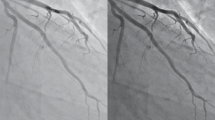Summary
In dog experiments the left coronary artery or the descending branch of the left coronary artery were perfused with the blood of the same dog out of an airchamber with various pressures. Mean coronary inflow was measured with an electromagnetic flowmeter. Mean transit times of Xe133 were calculated from the washout-curves recorded by external counting after single intracoronary injections. The mass of the perfused myocardium was calculated as the product of mean transit time of Xe133, coronary flow, and specific gravity of the myocardium.
In all experiments the mass of the perfused myocardium increased with elevation of perfusion pressure. In one group of experiments the values of the perfused myocardial mass increased continuously with elevation of perfusion pressure, whereas in a second group the mass of the perfused myocardium was relatively constant in the middle range of perfusion pressure.
Values of perfused myocardial mass obtained by excision after dye injection were higher than those calculated by the Xe133-technique.
Myocardial blood flow per 100 g·min was calculated by means of mean transit times, since the calculation by means of the down slope of the semilogarithmic plot mostly gives false results.
Similar content being viewed by others
Literatur
Conn, H. L.: Measurement of organ blood flow without blood sampling. J. clin. Invest. 34, 916 (1955).
Doutheil, U.: Kriterien der Coronarvasomotorik. Klin. Wschr. 43, 721 (1965).
—: Coronarvasomotorik unter l-Noradrenalin und Isopropylnoradrenalin nach Blockierung der adrenergischen β-Receptoren durch Nethalide. Pflügers Arch. ges. Physiol. 281, 181 (1964).
Gregg, D. E.: Effect of coronary perfusion pressure or coronary flow on oxygen usage of the myocardium. Circulat. Res. 13, 497 (1963).
—, and L. C. Fisher: Blood supply to the heart. In Handbook of Physiology, Section II, Vol. II, p. 1537. Washington: Amer. Physiol. Soc. 1963.
Herd, J. A., M. Hollenberg, G. T. Thorburn, H. H. Kopald, and A. C. Barger: Myocardial blood flow determined with Krypton-85 in unanesthetized dogs. Amer. J. Physiol. 203, 122 (1962).
Kahler, R. L., E. Braunwald, L. L. Kelminson, L. Kedes, C. A. Chidsey, and S. Segal: Effects of alterations of coronary blood flow on the oxygen consumption of the nonworking heart. Circulat. Res. 13, 501 (1963).
Khouri, E. M., and D. E. Gregg: Miniature electromagnetic flowmeter applicable to coronary arteries. J. appl. Physiol. 18, 1 (1963).
Kreuzer, H., u. W. Schoeppe: Zur Entstehung der Differenz zwischen systolischem Myokard- und Ventrikeldruck. Pflügers Arch. ges. Physiol. 278, 199 (1963).
Ross, J., F. Klocke, G. Kaiser, and E. Braunwald: Effect of alterations of coronary blood flow on the oxygen consumption of the working heart. Circulat. Res. 13, 510 (1963).
Ross, R. S., K. Ueda, P. R. Lichtlen, and J. R. Rees: Measurement of myocardial blood flow in animals and man by selective injection of radioactive inert gas into the coronary arteries. Circulat. Res. 15, 28 (1964).
Salisbury, P. F., C. E. Cross, and P. A. Rieben: Acute ischemia of inner layers of ventricular wall. Amer. Heart J. 66, 650 (1963).
Sarnoff, S. J., J. P. Gilmore, N. S. Skinner, A. G. Wallace, and J. H. Mitchell: Relation between coronary blood flow and myocardial oxygen consumption. Circulat. Res. 13, 514 (1963).
Weisberg, H., L. N. Katz, and E. Boyd: Influence of coronary flow upon oxygen consumption and cardiac performance. Circulat. Res. 13, 522 (1963).
Zierler, K. L.: Equations for measuring blood flow by external monitoring of radioisotopes. Circulat. Res. 16, 309 (1965).
Author information
Authors and Affiliations
Additional information
Mit Unterstützung der Deutschen Forschungsgemeinschaft.
Rights and permissions
About this article
Cite this article
Doutheil, U., Rohde, R. Bestimmung der Masse des perfundierten Myokards in Abhängigkeit vom Perfusionsdruck mit Hilfe der Xe133-Auswaschtechnik. Pflügers Archiv 288, 186–196 (1966). https://doi.org/10.1007/BF00362567
Received:
Issue Date:
DOI: https://doi.org/10.1007/BF00362567




